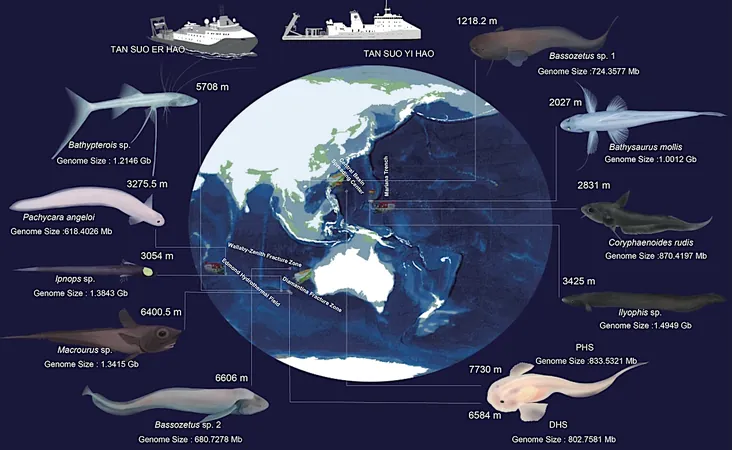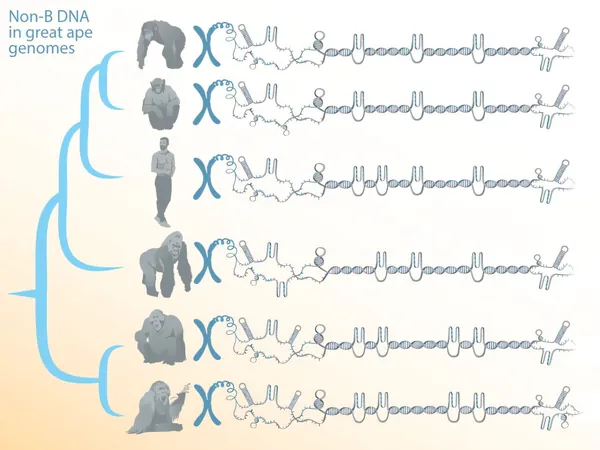
Unlocking the Secrets of the Ocean's Depths: Biodiversity Genomics Reveals Life in Extreme Conditions
2025-04-13
Author: Jacques
Exploring the Uncharted Depths of Our Oceans
The deep sea—vast, mysterious, and daunting—encompasses about 65% of our planet's surface. For years, it was believed to be a barren wasteland, particularly in its most extreme realm: the hadal zone, found at depths over 6,000 meters. Here, organisms endure crushing pressures, near-freezing temperatures, low oxygen levels, and perpetual darkness.
A Revelation in Deep-Sea Biology
Thanks to China's groundbreaking advancements in deep-sea exploration technology, this dark world is being redefined. Researchers are unveiling that the hadal zone acts as a hotspot for evolutionary wonders. Species like the hadal snailfish not only manage to survive but also foster unique ecosystems.
Groundbreaking Research from Leading Scientists
In a landmark study published in 'Cell', Professor HE Shunping and his team from the Institute of Hydrobiology (IHB) of the Chinese Academy of Sciences (CAS) collaborated with experts from several prestigious institutions to explore the genetic adaptations that allow these fish to thrive in Earth's most inhospitable conditions. Their research provides fresh insights into how life persists even in extreme environments.
Exploratory Expeditions Uncover Hidden Biodiversity
Utilizing advanced motherships, Tansuo Yihao and Tansuo Erhao, equipped with state-of-the-art manned submersibles—Shenhai Yongshi and Fendouzhe—the team undertook extensive sampling across the western Pacific and central Indian Ocean. The results? 11 unique deep-sea fish species from six major groups, collected from a staggering depth range of 1,218 to 7,730 meters.
Decoding the Evolutionary Pathways of Deep-Sea Fish
An analysis of genetic data revealed surprising truths about the evolutionary history of these creatures. The team confirmed a long-held theory suggesting two distinct pathways of adaptation. The 'ancient survivors' colonized the deep sea long before the Cretaceous mass extinction, while 'new immigrants' comprise the majority of today’s deep-sea fish, emerging after this mass extinction event approximately 60 million years ago.
Challenging Old Theories: New Genetic Findings
The study also disputes the long-accepted trimethylamine N-oxide (TMAO) hypothesis regarding deep-sea fish adaptation. While TMAO levels were thought to increase with depth, this trend falters beyond 6,000 meters. Instead, researchers identified a previously unnoticed mutation in the rtf1 gene across deep-sea fish at greater depths, highlighting a new genetic mechanism for adaptation to crushing pressures.
Environmental Concerns Surface Amid Discovery
Further analysis unveiled alarming levels of polychlorinated biphenyls (PCBs) in the liver tissues of hadal snailfish from the Mariana Trench, pointing fingers to human activities adversely affecting these remote ecosystems. This discovery raises pressing concerns about the conservation of our planet's deep-sea environments.
A New Era for Deep-Sea Research
This research, a component of the Global Deep-Sea Trenches Exploration Program (Global TREnD), not only unearths vital mechanisms allowing life to flourish in extreme conditions but also sets the stage for future interdisciplinary endeavors within biology, ecology, and deep-sea conservation. What secrets will the ocean depths reveal next?









 Brasil (PT)
Brasil (PT)
 Canada (EN)
Canada (EN)
 Chile (ES)
Chile (ES)
 Česko (CS)
Česko (CS)
 대한민국 (KO)
대한민국 (KO)
 España (ES)
España (ES)
 France (FR)
France (FR)
 Hong Kong (EN)
Hong Kong (EN)
 Italia (IT)
Italia (IT)
 日本 (JA)
日本 (JA)
 Magyarország (HU)
Magyarország (HU)
 Norge (NO)
Norge (NO)
 Polska (PL)
Polska (PL)
 Schweiz (DE)
Schweiz (DE)
 Singapore (EN)
Singapore (EN)
 Sverige (SV)
Sverige (SV)
 Suomi (FI)
Suomi (FI)
 Türkiye (TR)
Türkiye (TR)
 الإمارات العربية المتحدة (AR)
الإمارات العربية المتحدة (AR)